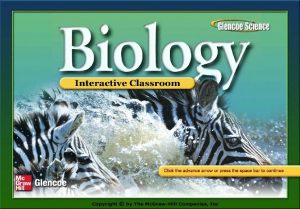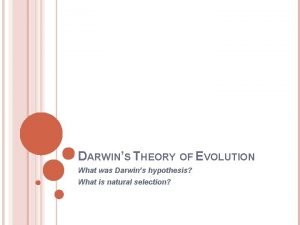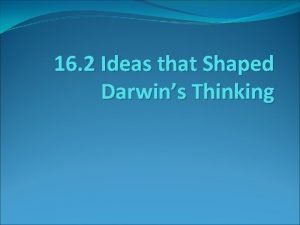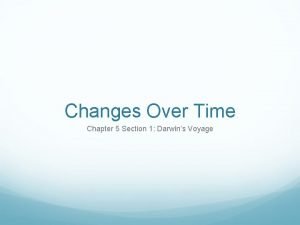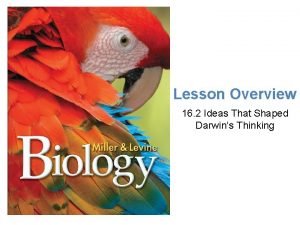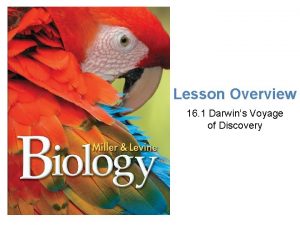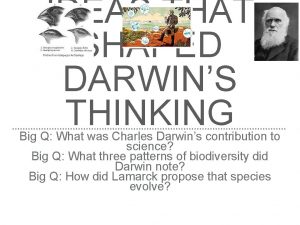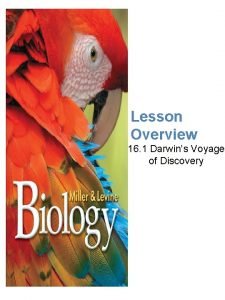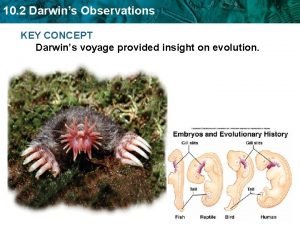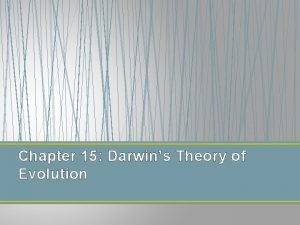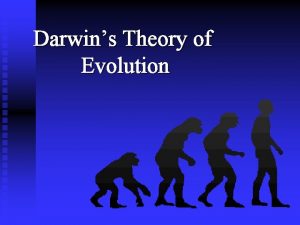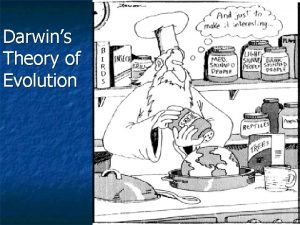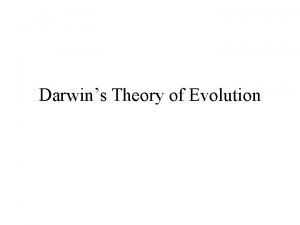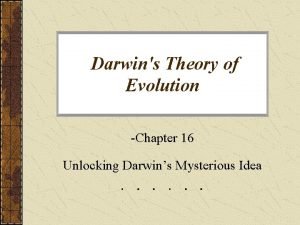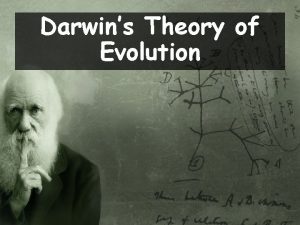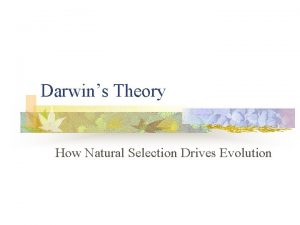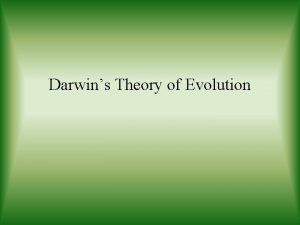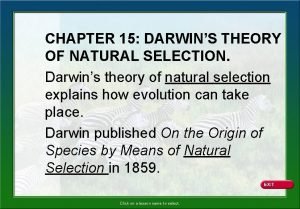Chapter 15 Darwins Theory of Evolution 15 1












- Slides: 12

Chapter 15 Darwin’s Theory of Evolution 15 -1 The Puzzle of Life’s Diversity

15 -1 Vocabulary Evolution. Change in a kind of organism over time; process by which modern organisms have descended from ancient organisms. Theory. Well-tested explanation that unifies a broad range of observations. Fossil. Preserved remain or evidence of an ancient organism.

The Puzzle of Life’s Diversity 1. Voyage of the Beagle a. In 1831, Darwin set sail around the world

A Trip Around the World While on his voyage around the world aboard the H. M. S. Beagle, Charles Darwin spent about one month observing life on the Galápagos Islands. There, he encountered some unique animals, such as finches and tortoises. 1. On a sheet of paper, list five animals that you have encountered in the past two days. 2. How do these animals differ from the finches and tortoises of the Galápagos Islands? (Examine Figures 15– 3 and 15– 4 in your textbook. ) 3. Propose a hypothesis to account for the differences between the animals that you observed and the finches and tortoises of the Galápagos Islands.

The Puzzle of Life’s Diversity b. Darwin made observations and collected evidence to propose a hypothesis about the way life changes over time i. ii. Evolution: change over time (modern organisms have descended from ancient organisms) Theory: a well-supported testable explanation of phenomena that have occurred in the natural world

The Puzzle of Life’s Diversity 2. Darwin’s Observations a. Patterns of Diversity i. Organisms survived and produced offspring in a variety of ways depending on their environment

The Puzzle of Life’s Diversity b. The Galapagos Islands i. These islands are close but have very different climates 1. Hood Island: sparse vegetation 2. Pinta Island: greater rainfall & various plants & animals 3. Isabella Island: rich vegetation easily reached

ii. The land tortoises were characteristic of their environment 1. Shell shape varied based upon need for body movement 2. Neck length reflected amount and types of food available Pinta Island Tower Marchena Intermediate shell Fernandina James Santa Cruz Isabela Santa Fe Hood Island Floreana Hood Saddle-backed shell

15 -1 Review What did Darwin’s travels reveal to him about the number and variety of living species? Darwin’s travels showed him that the diversity of living species was far greater than he had previously known.

15 -1 Review How did tortoises and birds differ among the islands of the Galapagos? Each Galapagos island had its own type of tortoises and birds that were clearly different from the tortoises and birds on other islands.

15 -1 Review What is evolution? Why is evolution referred to as a theory? Evolution, or change over time, is the process by which modern organisms have descended from ancient ones. Evolution is referred to as a theory because it is a well supported explanation of phenomena that have occurred in the natural world.

15 -1 Review What is a fossil? A fossil is the preserved remains of an ancient organism.
 Chapter 17 darwin's theory of evolution
Chapter 17 darwin's theory of evolution Chapter 15 section 1 darwins theory of natural selection
Chapter 15 section 1 darwins theory of natural selection What was darwins theory
What was darwins theory Section 15-2 ideas that shaped darwin's thinking
Section 15-2 ideas that shaped darwin's thinking Section 15-2 ideas that shaped darwin's thinking
Section 15-2 ideas that shaped darwin's thinking Adaptation
Adaptation Ideas that shaped darwins thinking
Ideas that shaped darwins thinking Lesson 1 darwins voyage of discovery
Lesson 1 darwins voyage of discovery Ideas that shaped darwins thinking
Ideas that shaped darwins thinking Lesson 1 darwins voyage of discovery
Lesson 1 darwins voyage of discovery Darwins observations
Darwins observations Chapter 15 darwin's theory of evolution section 15-1
Chapter 15 darwin's theory of evolution section 15-1 Chapter 15 darwin's theory of evolution section 15-1
Chapter 15 darwin's theory of evolution section 15-1

